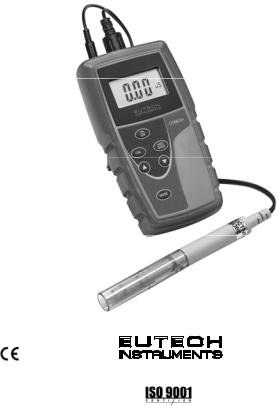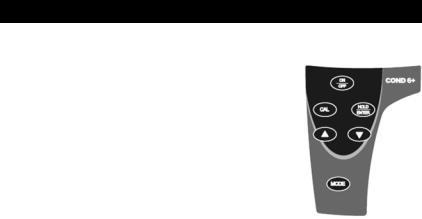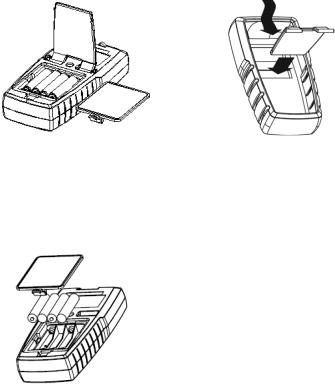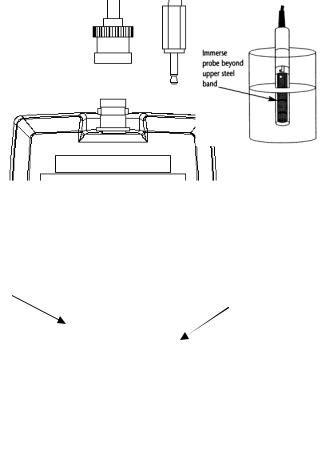Eutech instruments Cond 6+, Salt 6+, TDS 6+ Manual

Instruction Manual
Cond 6+ Conductivity/Temp
TDS 6+ TDS/Temp
Salt 6+ Salinity/Temp
Technology Made Easy ...
68X243635
Rev 0 02/09
Part of Thermo Fisher Scientific
Preface
This manual serves to explain the use of the Conductivity, TDS, and Salinity handheld meters. The models covered are the CON 6+, TDS 6+, and Salt 6+.
This manual functions in two ways: first as a step by step guide to help you operate the meter; second, it serves as a handy reference guide.
This manual is written to cover as many anticipated applications of the Conductivity, TDS, and Salinity handheld meters as possible. If there are doubts in the use of these meters, please do not hesitate to contact the nearest Eutech Instruments Authorized Distributor.
Eutech Instruments will not accept any responsibility for damage or malfunction to the meter caused by improper use of the instrument.
The information presented in this manual is subjected to change without notice as improvements are made, and does not represent a commitment on the part of Eutech Instruments Pte Ltd.
Copyright © 2009
Eutech Instruments Pte Ltd
Rev. 0 02/09
Table of Contents
1. |
|
INTRODUCTION........................................................................ |
1 |
2. |
|
GETTING STARTED.................................................................. |
2 |
2.1 |
Description of Keypad Functions ................................................................. |
2 |
|
2.2 |
Description of LCD Annunciators................................................................. |
3 |
|
2.3 |
Inserting & Removing the Rubber Armour / Stand....................................... |
4 |
|
2.4 |
Inserting New Batteries ............................................................................... |
4 |
|
2.5 |
Battery Replacement................................................................................... |
5 |
|
2.6 |
Electrode Information .................................................................................. |
5 |
|
2.7 |
Connecting the Electrode ............................................................................ |
6 |
|
2.8 |
Switching the Meter On ............................................................................... |
7 |
|
2.9 |
Changing Mode........................................................................................... |
8 |
|
3. |
|
CALIBRATION........................................................................... |
9 |
3.1 |
Important Information on Meter Calibration ................................................. |
9 |
|
3.2 |
Preparing the Meter for Calibration.............................................................. |
10 |
|
3.3 |
Selection of Auto or Manual Calibration (COND 6+).................................... |
10 |
|
3.4 |
Using Automatic Calibration (COND 6+)...................................................... |
11 |
|
3.5 |
Manual Calibration ...................................................................................... |
13 |
|
3.6 |
Temperature Calibration.............................................................................. |
14 |
|
4. |
|
MEASUREMENT ....................................................................... |
15 |
4.1 |
With Automatic Temperature Compensation (ATC)..................................... |
15 |
|
4.2 |
Without ATC (Manual Temperature Compensation).................................... |
15 |
|
4.3 |
Taking Measurements................................................................................. |
16 |
|
4.4 |
Using Manual Ranging Function (COND 6+, TDS 6+)................................. |
16 |
|
4.5 |
HOLD Function............................................................................................ |
18 |
|
5. |
|
ADVANCED SETUP FUNCTIONS ............................................ |
18 |
5.1 |
Advanced Setup Overview .......................................................................... |
18 |
|
5.2 |
Select Cell Constant (COND 6+, TDS 6+ only)............................................ |
20 |
|
5.3 |
Automatic Calibration (COND 6+ only) ........................................................ |
20 |
|
5.4 |
Setting the TDS Factor (TDS 6+ only) ......................................................... |
21 |
|
5.5 |
Temperature Coefficient .............................................................................. |
21 |
|
5.6 |
Normalization Temperature ......................................................................... |
22 |
|
5.7 |
Single-Point Calibration (COND 6+, TDS 6+ only)....................................... |
22 |
|
5.8 |
Restore Factory Default Values................................................................... |
23 |
|
6. |
PROBE CARE AND MAINTENANCE ....................................... |
23 |
|
7. |
|
TROUBLESHOOTING............................................................... |
24 |
8. |
|
SPECIFICATIONS / FEATURES ............................................... |
25 |
9. |
|
CONDUCTIVITY THEORY......................................................... |
27 |
10. |
CALIBRATION TIPS.................................................................. |
29 |
11. |
CALCULATING TDS CONVERSION FACTOR ........................ |
30 |
12. |
CALCULATING TEMPERATURE COEFFICIENTS .................. |
31 |
13. |
REPLACEMENTS AND ACCESSORIES.................................. |
32 |
14. |
WARRANTY .............................................................................. |
33 |
15. |
RETURN OF ITEMS .................................................................. |
33 |

Instruction Manual |
COND 6+, TDS 6+, SALT 6+ |
1. INTRODUCTION
Thank you for purchasing the COND 6+, TDS 6+, or SALT 6+ meter. These microprocessor-based handheld meters are economical and easy to use. It has a large custom LCD (Liquid Crystal Display) for clear and easy reading.
The Cond 6+ measures conductivity (µS/cm or mS/cm) and temperature (°C) while the TDS 6+ measures total dissolved solids (TDS) in parts per million (ppm) or parts per thousand (ppt) and temperature (°C). Each measures up to 5 different ranges and can automatically switch to appropriate measuring range.
The Salt 6+ measures salinity (as NaCl) in % salt or ppt and temperature (°C).
Your meter includes an electrode (cell constant K = 1.0) with built-in temperature sensor (ECCONSEN91B), rubber armour, 4 alkaline “AAA” batteries, instruction manual and warranty card.
Please read this manual thoroughly before operating your meter.
To order other accessories and buffer standard solutions, please refer to the accessories section for more information.
-1-

Instruction Manual |
COND 6+, TDS 6+, SALT 6+ |
2. GETTING STARTED
2.1Description of Keypad Functions
Your meter has 6 keys on its splash-proof keypad. Some buttons have multiple functions depending on the mode of operation.
ON/OFF Powers meter on and off. Meter starts up in the measurement mode that you last switched off from.
CAL Enters into calibration mode. Pressing while in calibration mode will abort calibration without confirming value.
MODE Selects desired measurement mode. When pressed simultaneously with ON/OFF, it will take you into the SETUP mode. See ADVANCED SETUP section for more information.
HOLD Freezes measured reading. Press again to resume live reading.
ENTER Confirms calibration value in calibration mode and confirm selections in SETUP mode.
Increment values during calibration mode or scroll through SETUP. Activates manual ranging function during conductivity / TDS measurement.
Decrement values during calibration mode.
-2-

Instruction Manual |
COND 6+, TDS 6+, SALT 6+ |
2.2Description of LCD Annunciators
Your meter has a large custom LCD that consists of 4-digit segments plus annunciators for uS/mS (Cond 6+), ppm/ppt (TDS 6+), or ppt/% (Salt 6+) and °C (temperature).
7 |
6 |
|
5 |
|
|
|||
|
|
|
|
|
|
|
|
|
|
|
|
|
|
|
|
|
|
HO |
LO |
% |
|
4 |
||||
|
|
|
|
|
° C |
|
||
|
|
|
|
|
|
|||
|
|
|
|
|
m |
|
|
|
|
|
|
|
|
3 |
|||
|
|
|
|
|
µ S |
|||
|
|
|
|
|
pptm |
|
2 |
|
|
|
|
|
|
|
|||
|
|
|
|
|
|
|||
|
|
|
|
|
|
|
|
|
1
1.Primary display
2.Parts per million (ppm) (TDS 6+ only).
Parts per thousand (ppt) (TDS 6+ & Salt 6+ only).
3.Milli-Siemens/cm (mS) or micro-Siemens/cm (µS) indicator (Cond 6+ only).
4.Temperature indicator.
5.Percentage indicator for temperature coefficient or % Salinity (Salt 6+ only).
6.“LO” = low battery condition.
7.“HO” = HOLD function is activated and reading is frozen.
-3-

Instruction Manual |
COND 6+, TDS 6+, SALT 6+ |
2.3Inserting & Removing the Rubber Armour / Stand
1.To remove meter from rubber armour, push out from the bottom edges of meter until it is completely out of boot. Ensure that your electrode cables are not connected.
Figure A.
2.To insert meter into armour, slide in from the top of meter before pushing the bottom edges of meter down to set it into position. Lift up the stand at the back of meter for bench top applications if necessary. Figure B.
Figure A |
Figure B |
2.4Inserting New Batteries
The battery compartment is found at the back of instrument. To open the battery compartment, push in the direction of arrow and lift up the cover. Note the polarity of battery before inserting into position. After replacement, place cover back and press down until it locks.
-4-

Instruction Manual |
COND 6+, TDS 6+, SALT 6+ |
2.5Battery Replacement
A “LO” annunciator in the LCD alerts you when battery power is running low. See below.
LO
µS
"LO" Battery Condition
Caution: Power off the meter when changing battery.
2.6Electrode Information
Your meter includes an electrode with a BNC connector (ECCONSEN91B) having a nominal cell constant of k = 1.0, and a built-in temperature sensor. The Ultem-body housing has good chemical resistant properties. The electrode design offers fast temperature response and reduces air entrapment, ensuring accurate, repeatable, and stable readings.
The wettable materials of the probe include:
1.Polyetherimide (Ultem) – protective probe guard
2.Polybutylterphalate (Valox) – sensor housing
3.Stainless Steel (SS 304) – 2 steel bands
The protective probe guard can be maintenance but must be re-attached calibration. Erroneous results will occur removed.
removed temporarily for during measurement and while the probe guard is
Always immerse the probe beyond upper steel band for best results. Use the fill line on the outside of the probe guard for reference.
-5-

Instruction Manual |
COND 6+, TDS 6+, SALT 6+ |
1.DO NOT measure or calibrate without the protective probe guard in place.
2.Immersion above the protective guard is not recommended. The cable can be submerged briefly but is not designed for continuous immersion.
See “Probe Care and Maintenance” for more information.
2.7Connecting the Electrode
1.To connect electrode, align the connector slots with the posts of meter’s socket and rotate connector clockwise until it locks.
2.To remove, rotate the connector in anti-clockwise direction until it unlocks, and slide the connector off the socket.
3.Insert the mini phono jack of temperature sensor into the socket on the meter as shown below.
BNC connector |
|
2.5 mm mini phono |
|
|
for temperature |
|
||
|
|
|
-6-

Instruction Manual |
COND 6+, TDS 6+, SALT 6+ |
2.8Switching the Meter On
Press ON/OFF to power up your meter. Your meter will cycle through various setup parameters when switched on.
1.The first screen shows the model [Con6] [tdS6] [SAL6].
2.The second screen shows the nominal cell constant value. The Cond 6+ and TDS 6+ meters can accept electrodes with k = 0.1, 1.0 or 10.0 nominal cell constants. The Salt 6+ can be used with 1.0 only. Default value is k = 1.0 [C 1.0].
See Section 5.2 Advanced Setup to modify.
3.The third screen shows the Normalization Temperature which can be set to 25 °C or 20 °C. Default value is 25 °C [t 25.0 °C].
See Section 5.6 Advanced Setup to modify.
4.The fourth screen shows the Temperature Coefficient which can be set from 0.0 to 3.0 % per °C. Default value is 2.1 %/°C [t 2.1%].
See Section 5.5 Advanced Setup to modify.
5.All LCD segments light for 2 seconds before entering measurement mode. Note: the meter will use the measurement mode that was in use when it was previously powered off.
Cond 6+
ON |
|
|
|
m |
|
|
|
|
|
|
|
°C |
|
|
|
|
|
|
|
|
|||||
OFF |
µS |
|
|
|
|
|
|
|
|
|||
|
|
|
|
|
|
|
|
|
|
|
|
|
|
|
|
|
|
|
|
|
|
|
|
|
|
|
|
|
|
|
|
|
|
|
|
|
|
|
|
|
|
|
|
|
|
HO LO |
MAX MIN pH % |
|
|
% |
|
|
|
|
|
|
|
|
|
°C°F |
|
|
|
|
|
|
|
|
µ S |
|
|
|
m |
|
|
|
|
|
|
|
|
|
|
|
µ S |
|
|
|
|
|
|
|
|
|
|
|
|
|
pptmV |
|
|
|
|
|
|
|
|
|
|
|
|
|
|
|
|
|
|
|
|
|
|
|
|
|
|
|
|
|
|
|
|
|
|
Measurement Mode |
|
|
|
|
|
|||
-7-
